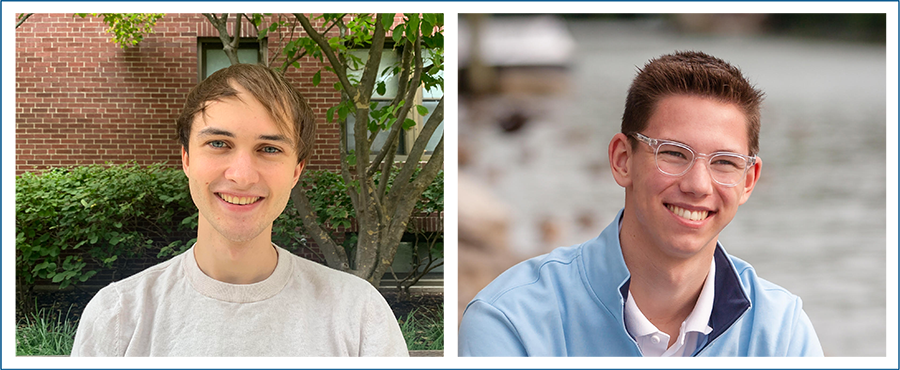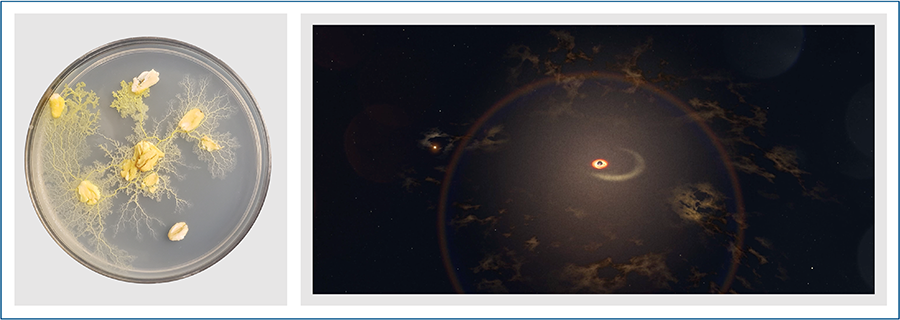
December 2022 (Volume 31, Number 11)
Undergrads Win Apker Prize for Work on Slime Mold and Black Holes
The 2022 award has gone to students in biophysics and astrophysics.
By Liz Boatman | November 10, 2022

Adam Dionne (left) and Matthew Cufari, recipients of the 2022 Apker Award.
Each year, the American Physical Society recognizes undergraduate achievements in physics with the LeRoy Apker Award. This year’s recipients are Matthew Cufari, a senior at Syracuse University, and Adam Dionne, now in his first year of a doctoral program at Harvard University, for work he completed as a student at Williams College.
Dionne investigated nutrient transport in slime mold, while Cufari built a model to explain the origin of a periodic burst of light emitted from a distant galaxy.
Dionne spent many hours in the lab, bent over Petri dishes as he cultured his organism, Physarum polycephalum — feeding it oat flakes, slime mold’s favorite meal. He observed spatial patterns in nutrient distribution in the slime mold, which he then modeled using principles of network theory.
“Physarum can do things like solve a maze or create this optimal distribution network,” says Dionne, even though it has no nervous system and its transport network is “very decentralized and simple.” He worked with Henrik Ronellenfitsch, then an assistant professor at Williams, to develop a theory underpinning the organism’s behaviors. The duo partnered with assistant professor Katharine Jensen for the experimental portion.
“I could start to see how the model came together in a way that demonstrated how this organism, Physarum, really organized itself,” says Dionne.
Cufari, meanwhile, was studying a galactic nucleus, known as ASASSN-14ko, in a distant region of the sky. Other researchers had reported on a periodic burst of light from ASASSN-14ko, emitted every 114 days. They speculated that the source could be a large star gravitationally tethered to a black hole at the galaxy’s center, emitting the flare every time the star looped around and passed close to the black hole.
But they couldn’t explain how a star could have been captured in an orbit tight enough to give rise to the short periodicity of 114 days. So Cufari and his project advisor, assistant professor Eric Coughlin, set out to develop a model that would explain, and then simulate, how this could happen. The duo ultimately demonstrated that the black hole likely captured the large star from a nearby binary star system, in a process known as the Hills mechanism.
At some points during the project, their model didn’t seem to work. “It was often difficult to tell if the model couldn’t explain the origin of ASASSN-14ko, or a piece just needed to be reconsidered,” Cufari says.
Despite the challenges, Cufari’s calculations were spot on. “[When] you work on a model for months that yields predictions in magnificent agreement with observation — it’s really amazing,” he says.

Credit: Adam Dionne (photo at left). NASA’s Goddard Space Flight Center/Chris Smith (USRA/GESTAR) (illustration at right).
Dionne studied the slime mold Physarum polycephalum and its complex system of distributing nutrients (left). Cufari studied the galactic nucleus ASASSN-14koA, whose regular bursts of light are believed to be caused by a black hole siphoning matter from an orbiting star.
Although maze-solving slime mold and hungry black holes seem unrelated, both projects relied on computer simulations, which the students mastered thanks to their undergraduate computer science courses.
“It’s really easy to lose sight of how revolutionary [computers] truly are,” says Dionne. “Seeing how the cutting edge of research uses them to understand systems … was really inspiring.”
Both students credit their research with making physics feel relevant to the real world. Cufari says he learned how investments in the optical systems of telescopes have impacted a range of technologies, like instruments used in medicine to diagnose and treat disease. And Dionne underscores that “whimsical” slime mold can do more than solve mazes — it can inform our understanding of decentralized distribution in large networks, which has implications for modern systems like power grids, he says.
So what’s next for the two physicists?
Cufari, who once thought he would be a physician or lawyer, now plans to pursue a career in science because of “the type of problem solving that goes into physics research — the open-ended questions,” he says. He’s also drawn to the field’s applications — for example, to engineering for clean energy — and the role physicists can play in “pushing technology forward, making life more equitable, more accessible for everyone, and improving the world that we have today.”
Cufari is applying to graduate programs to further his interests in plasma astrophysics, in the hopes of becoming a research scientist or professor, he says.
Dionne, in his first semester at Harvard, is already focused on “trying to find a way to do research that is both meaningful to me and [that helps] out other people.” For him, science communication is key. Physicists have “a role to play, an onus to communicate … with the public in a way that they can understand,” he says. Part of this onus for physicists includes “restoring trust” that the public has lost in recent years, by becoming better communicators.
Beyond that, Dionne says he’s still charting his course, in part because, as a first-generation college student turned first-generation graduate student, “I didn’t really know that a PhD was an option for my life until I was in college.”
For now, “I’m just trying to become the best scientist I can,” he says, “because it’s what I enjoy and [it’s] a really meaningful career to pursue.”
Liz Boatman is a staff writer for APS News.
©1995 - 2024, AMERICAN PHYSICAL SOCIETY
APS encourages the redistribution of the materials included in this newspaper provided that attribution to the source is noted and the materials are not truncated or changed.
Editor: Taryn MacKinney
December 2022 (Volume 31, Number 11)
Articles in this Issue
